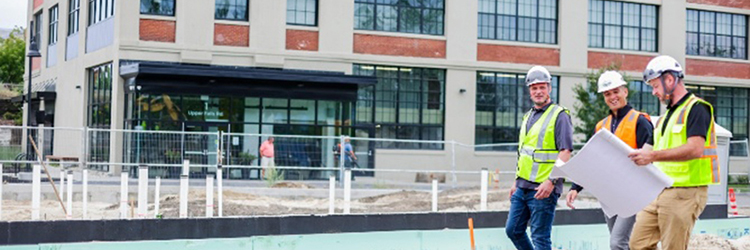A developer may be as important for individual health as a doctor - by Thomas House

THA Architects, LLC
A developer may be as important for individual health as a doctor.
Persistent cough? Frequent communicable illness? Maybe the TV ads should say “Have you considered a healthy building? Ask your developer or architect.”
The typical American spends 87% of their time indoors, even in good times. An indoors with poor air circulation and toxic off gasses that result in air quality as much as 5 times worse than what’s outdoors.
Water quality, insufficient natural light, and ambient noise add factors of complexity to creating a healthy indoor environment - whether for homes or offices, which at the moment are often the same space.
Which brings us to the communicable disease part - the need to ensure that access involving hallways such as multifamily housing or many office buildings includes multiple points of access, and sometimes barriers to cross traffic. We’ve learned that many of the precautions taken during COVID-19 greatly reduced the transmission of the flu….and the common cold. Nobody misses those.
A significant contribution would be active design, beginning with centrally and highly public stairs that would invite use the way fire code, steel and concrete stairways do not. And these would complement indoor active design implementations such as exercise facilities and outdoor features like pools, walking tracks, bike trails, and playground equipment.
What is a healthy building?
The concept of the healthy building is a recent development that considers the importance of buildings and the built environment in shaping the physical, psychological, and social well-being of its occupants.
Until the pandemic - and now the Texas grid failure - this aspect of design and development is no longer a boutique consideration. It has wide-ranging implications and needs to be (or soon will be) incorporated into our codes.
The main touch points are indoor air quality, fresh air supply (ventilation), daylight, dust & allergens, thermal conditioning, moisture, water quality, and noise. The importance of holistically taking these into account as a whole concept is now imperative. Texas in February of 2021 is a case in point, where most of these touchpoints collapsed all at once to great personal and financial cost, costs that will continue to accrue for a decade or more.
The air you breathe
The T.H. Chan School of Public Health at Harvard singles out ventilation as particularly important. It has an impact on the quality of life at home, work, school, and the community.
Complicating the fact that recycled indoor air is laden with accumulated toxins, the air outdoors may only be slightly better. And yet we need to bring that outside air indoors. In fact, their white paper notes, most of an individual’s exposure to outdoor pollution may occur indoors. Thus intake, routing, and filtration are vitally important as is maintenance.
Air quality determines a wide array of small and sometimes significant effects that impact not just home life, but workplace and classroom productivity which are compounded if the circulation there is also poor. Unit circulation, as the pandemic makes clear, is not an afterthought.
Common indoor pollutants include carbon monoxide, particulate matter, and volatile organic compounds found in some carpeting, wall coverings, cabinet fixtures, and paint. In public areas maintained by a property manager, cleaning compounds and pesticides are top of the list of things that would likely stand better solutions.
Thermal conditioning should be separate from ventilation, and allow for individualized or zone controls in larger spaces. This not only improves the cost of operating such a system, it vastly improves the sustainability factor and reduces the cost of maintenance.
Is there a fungus among us?
Dampness, moisture, and mold are an axis of evil, silently extracting costs not just in health effects on residents, employees, and students of any kind of facility, but mitigation is costly to building owners and investors and the health effects of treatment can be as bad as the health effects of the problem.
Finishing materials are pivotal in areas with high transient moisture exposure, especially bathrooms. Sustainable material choices are much narrower in these areas, where the moisture needs to be kept from penetrating into (or through) the materials themselves.
Bringing the outdoors in
Water, daylight, and plant life are all meaningful aspects to the quality of experience in the interiors of the built environment.
We only have one word to say about water: Flint.
And it is equally important to provide as much solar-temperature light as possible - especially making natural light available the maximum extent possible, supplemented by artificial lighting. Softer, warm light should also be available for those times of the day when our circadian rhythms need less blue in the ambient light temperature.
And both water and light are the stuff of (plant) life, and in terms of bringing the outdoors in, opportunities for biophilic enhancement possibly the only item in this summary that might be considered by some, not us, to be just ever so slightly a luxury (which is the Latin word for ‘light,’ which is a necessity).
Thomas House, AIA, is the principal of THA Architects, LLC, Stratham, N.H.
Reveler Development celebrates final phase of work at The Levee - new 51-unit apartment building in Biddeford


Residential is here to untie the office space doom loop - by Thomas House

Interest rates and inflation - by Matthew Bacon
As we all know, interest rates have been changing drastically, with movement in both directions, depending on the type and term of financing. The Federal Open Market Committee has taken drastic action in efforts to curb abnormally high inflation, but it hasn’t controlled labor cost growth to the extent that was intended.

The Greater Portland industrial mid-year market update - by Nate Roop

Maine multifamily outlook: Opportunities in Portland, Bangor, and Lewiston-Auburn - Blake Wright and Kristie Russell
The multifamily market in Maine’s major cities presents a diverse range of opportunities for investors. We looked at the potential benefits and unique characteristics of three major submarkets in the state: Portland, Bangor, and Lewiston-Auburn. The information below is based on research done in CoStar and county registries, and focuses on multifamily properties that have four or more units.

 (1) (1).png)





.png)


.png)